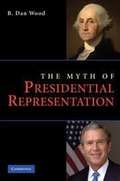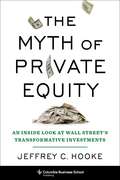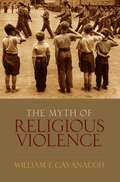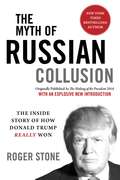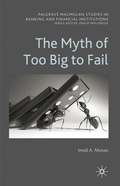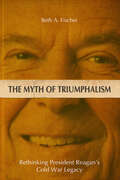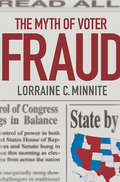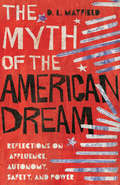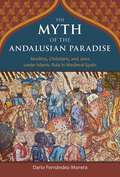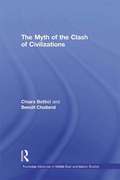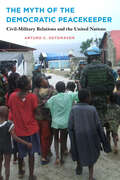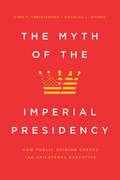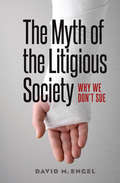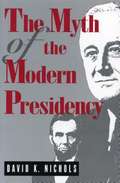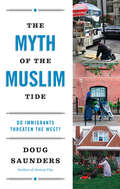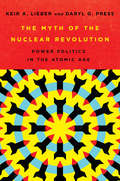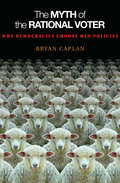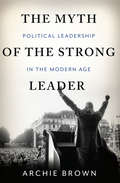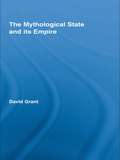- Table View
- List View
The Myth of Post-Reform Income Stagnation: Evidence from Brazil and Mexico
by Marcos Chamon Irineu de Carvalho FilhoA report from the International Monetary Fund.
The Myth of Presidential Representation
by B. Dan WoodIn The Myth of Presidential Representation, B. Dan Wood evaluates the nature of American presidential representation, examining the strongly embedded belief - held by the country's founders, as well as current American political culture and social science theory - that presidents should represent the community at large. Citizens expect presidents to reflect prevailing public sentiment and compromise in the national interest. Social scientists express these same ideas through theoretical models depicting presidential behavior as driven by centrism and issue stances adhering to the median voter. Yet partisanship seems to be a dominant theme of modern American politics. Do American presidents adhere to a centrist model of representation as envisioned by the founders? Or, do presidents typically attempt to lead the public toward their own more partisan positions? If so, how successful are they? What are the consequences of centrist versus partisan presidential representation? The Myth of Presidential Representation addresses these questions both theoretically and empirically.
The Myth of Private Equity: An Inside Look at Wall Street’s Transformative Investments
by Jeffrey C. HookeOnce an obscure niche of the investment world, private equity has grown into a juggernaut, with consequences for a wide range of industries as well as the financial markets. Private equity funds control companies that represent trillions of dollars in assets, millions of employees, and the well-being of thousands of institutional investors and their beneficiaries. Even as the ruthlessness of some funds has made private equity a poster child for the harms of unfettered capitalism, many aspects of the industry remain opaque, hidden from the normal bounds of accountability.The Myth of Private Equity is a hard-hitting and meticulous exposé from an insider’s viewpoint. Jeffrey C. Hooke—a former private equity executive and investment banker with deep knowledge of the industry—examines the negative effects of private equity and the ways in which it has avoided scrutiny. He unravels the exaggerations that the industry has spun to its customers and the business media, scrutinizing its claims of lucrative investment returns and financial wizardry and showing the stark realities that are concealed by the funds’ self-mythologizing and penchant for secrecy. Hooke details the flaws in private equity’s investment strategies, critically examines its day-to-day operations, and reveals the broad spectrum of its enablers. A bracing and essential read for both the financial profession and the broader public, this book pulls back the curtain on one of the most controversial areas of finance.
The Myth of Religious Violence
by William T. CavanaughThe book challenges the conventional wisdom that religion has a dangerous tendency to promote violence and examines thoroughly how the twin categories of religion and the secular are constructed.
The Myth of Russian Collusion: The Inside Story of How Donald Trump REALLY Won
by Roger StoneFor the first time in paperback, New York Times best-selling author Roger Stone’s insider tell-all about the presidential campaign that shocked the world. This consummate political strategist continues to be front page news and has updated the book to respond to Robert Mueller’s charges.Two years ago, Roger Stone, a New York Times bestselling author, longtime political adviser and friend to Donald Trump, and consummate Republican strategist, gave us Making of the President 2016—the first in-depth examination of how Trump’s campaign delivered the biggest presidential election upset in history. But since then, the Deep State political establishment has worked tirelessly to undo those results. The Myth of Russian Collusion adds to and updates Stone’s initial work to set the record straight. Trump’s election win was a resounding repudiation of the failed leadership of both parties. The American people wanted something new, and President Trump has delivered: his tax cuts and regulatory rollbacks have given us the strongest economy in American history, he is relentless in his efforts to protect American citizens, and he refuses to do business as usual. But America’s ruling elite and liberal media, feeling threatened, have conspired to create the biggest witch hunt in our country’s history. The phony narrative that Trump was in cahoots with Vladimir Putin, Mueller’s charges that Roger Stone knew about the Wikileaks emails before release—all is debunked here. With a new introduction that responds to the Mueller investigation, The Myth of Russian Collusion is the true story of the Trump campaign that the establishment doesn’t want you to believe.
The Myth of Too Big to Fail
by Imad A. MoosaThe book presents arguments against the taxpayers'-funded bailing out of failed financial institutions, and puts forward suggestions to circumvent the TBTF problem, including some preventive measures. It ultimately argues that a failing financial institution should be allowed to fail without fearing an apocalyptic outcome.
The Myth of Triumphalism: Rethinking President Reagan's Cold War Legacy (Studies In Conflict, Diplomacy, And Peace Ser.)
by Beth A. FischerThis historical study dismantles the myth of Reagan’s hardline victory and sheds light on his true diplomatic success in cooperation with Gorbachev.Did President Reagan’s hawkish policies destroy the Soviet Union and enable the United States to win the Cold War? Many Americans believe this to be the case. In this view?known as “triumphalism”?Reagan’s denunciations of the “evil empire” and his military buildup compelled Moscow to admit defeat. The president’s triumph demonstrates that America’s leaders should stand strong and threaten adversaries into submission.Drawing on both US and Soviet sources, this study demonstrates that triumphalism is based on a series of falsehoods about President Reagan’s intentions, his policies, and the impact his administration had on the Soviet Union. In reality, the president’s initially hardline posture undermined US interests and brought the superpowers to the brink of war. Success only came when Reagan changed his approach to one of cooperation.Together, President Reagan and General Secretary Gorbachev were able to accomplish what no one at the time thought possible?the peaceful conclusion of the Cold War. The president’s opposition to nuclear weapons, his determined leadership, and his dedication to diplomacy are his most enduring legacies.
The Myth of Voter Fraud
by Lorraine C. MinniteAllegations that widespread voter fraud is threatening to the integrity of American elections and American democracy itself have intensified since the disputed 2000 presidential election. The claim that elections are being stolen by illegal immigrants and unscrupulous voter registration activists and vote buyers has been used to persuade the public that voter malfeasance is of greater concern than structural inequities in the ways votes are gathered and tallied, justifying ever tighter restrictions on access to the polls. Yet, that claim is a myth. In The Myth of Voter Fraud, Lorraine C. Minnite presents the results of her meticulous search for evidence of voter fraud. She concludes that while voting irregularities produced by the fragmented and complex nature of the electoral process in the United States are common, incidents of deliberate voter fraud are actually quite rare. Based on painstaking research aggregating and sifting through data from a variety of sources, including public records requests to all fifty state governments and the U.S. Justice Department, Minnite contends that voter fraud is in reality a politically constructed myth intended to further complicate the voting process and reduce voter turnout. She refutes several high-profile charges of alleged voter fraud, such as the assertion that eight of the 9/11 hijackers were registered to vote, and makes the question of voter fraud more precise by distinguishing fraud from the manifold ways in which electoral democracy can be distorted. Effectively disentangling misunderstandings and deliberate distortions from reality, The Myth of Voter Fraud provides rigorous empirical evidence for those fighting to make the electoral process more efficient, more equitable, and more democratic.
The Myth of the American Dream: Reflections on Affluence, Autonomy, Safety, and Power
by D. L. Mayfield★ Publishers Weekly starred review.
The Myth of the Andalusian Paradise: Muslims, Christians, and Jews under Islamic Rule in Medieval Spain
by Dario Fernandez-MoreraA finalist for World Magazine's Book of the Year! Scholars, journalists, and even politicians uphold Muslim-ruled medieval Spain—"al-Andalus"—as a multicultural paradise, a place where Muslims, Christians, and Jews lived in harmony. There is only one problem with this widely accepted account: it is a myth. In this groundbreaking book, Northwestern University scholar Darío Fernández-Morera tells the full story of Islamic Spain. The Myth of the Andalusian Paradise shines light on hidden history by drawing on an abundance of primary sources that scholars have ignored, as well as archaeological evidence only recently unearthed. This supposed beacon of peaceful coexistence began, of course, with the Islamic Caliphate's conquest of Spain. Far from a land of religious tolerance, Islamic Spain was marked by religious and therefore cultural repression in all areas of life and the marginalization of Christians and other groups—all this in the service of social control by autocratic rulers and a class of religious authorities. The Myth of the Andalusian Paradise provides a desperately needed reassessment of medieval Spain. As professors, politicians, and pundits continue to celebrate Islamic Spain for its "multiculturalism" and "diversity," Fernández-Morera sets the historical record straight—showing that a politically useful myth is a myth nonetheless.
The Myth of the Clash of Civilizations (Routledge Advances in Middle East and Islamic Studies)
by Chiara Bottici Benoît ChallandWhile globalization unifies the world, divisions re-emerge within it in the form of a spectacular separation between Islam and the West. How can it be that Huntington’s contested idea of a clash of civilizations became such a powerful political myth through which so many people look at the world? Bottici and Challand disentangle such a process of myth-making both in the West and in Muslim majority countries, and call for a renewed critical attitude towards it. By analysing a process of elaboration of this myth that took place in academic books, arts and media, comics and Hollywood films, they show that the clash of civilizations has become a cognitive scheme through which people look at the world, a practical image on the basis of which they act on it, as well as a drama which mobilizes passions and emotions. Written in a concise and accessible way, this book is a timely and valuable contribution to the academic literature, and more generally, to the public debate. As such, it will be an important reference for scholars and students of political science, sociology, philosophy, cultural studies, Middle Eastern politics and Islam.
The Myth of the Common School
by Charles Leslie GlennFrom the author: Think of this rather as an extended meditation on the history of an idea, indeed of a complex of ideas so powerfully enchanting in their continuing effect that they may fairly be called a "myth": the common school. The myth of the common school as crucible of a single national identity, as the hothouse in which young sprouts are trained to a single state-approved pattern, is my topic here.
The Myth of the Democratic Peacekeeper: Civil-Military Relations and the United Nations
by Arturo C. SotomayorIf democratic principles do not just "rub off" onto United Nations peacekeepers, what positive or negative implications can be observed?Winner of the Luciano Tomassini Latin American Relations Book Award of the Luciano Tomassini Latin American RelationsThe Myth of the Democratic Peacekeeper reevaluates how United Nations peacekeeping missions reform (or fail to reform) their participating members. It investigates how such missions affect military organizations and civil-military relations as countries transition to a more democratic system.Two-thirds of the UN’s peacekeepers come from developing nations, many of which are transitioning to democracy as well. The assumption is that these "blue helmet" peacekeepers learn not only to appreciate democratic principles through their mission work but also to develop an international outlook and new ideas about conflict prevention. Arturo C. Sotomayor debunks this myth, arguing that democratic practices don’t just "rub off" on UN peacekeepers. So what, if any, benefit accrues to these troops from emerging democracies?In this richly detailed study of a decade’s worth of research (2001–2010) on Argentine, Brazilian, and Uruguayan peacekeeping participation, Sotomayor draws upon international socialization theory and civil-military relations to understand how peacekeeping efforts impact participating armed forces. He asks three questions: Does peacekeeping reform military organizations? Can peacekeeping socialize soldiers to become more liberalized and civilianized? Does peacekeeping improve defense and foreign policy integration?His evaluation of the three countries’ involvement in the UN Stabilization Mission in Haiti reinforces his final analysis—that successful democratic transitions must include a military organization open to change and a civilian leadership that exercises its oversight responsibilities.The Myth of the Democratic Peacekeeper contributes to international relations theory and to substantive issues in civil-military relations and comparative politics. It provides a novel argument about how peacekeeping works and further insight into how international factors affect domestic politics as well as how international institutions affect democratizing efforts.
The Myth of the Imperial Judiciary: Why the Right is Wrong About the Courts
by Mark KozlowskiAnalysis of judicial activity.
The Myth of the Imperial Presidency: How Public Opinion Checks the Unilateral Executive
by Douglas L. Kriner Dino P. ChristensonThroughout American history, presidents have shown a startling power to act independently of Congress and the courts. On their own initiative, presidents have taken the country to war, abolished slavery, shielded undocumented immigrants from deportation, declared a national emergency at the border, and more, leading many to decry the rise of an imperial presidency. But given the steep barriers that usually prevent Congress and the courts from formally checking unilateral power, what stops presidents from going it alone even more aggressively? The answer, Dino P. Christenson and Doulas L. Kriner argue, lies in the power of public opinion. With robust empirical data and compelling case studies, the authors reveal the extent to which domestic public opinion limits executive might. Presidents are emboldened to pursue their own agendas when they enjoy strong public support, and constrained when they don’t, since unilateral action risks inciting political pushback, jeopardizing future initiatives, and further eroding their political capital. Although few Americans instinctively recoil against unilateralism, Congress and the courts can sway the public’s view via their criticism of unilateral policies. Thus, other branches can still check the executive branch through political means. As long as presidents are concerned with public opinion, Christenson and Kriner contend that fears of an imperial presidency are overblown.
The Myth of the Imperial Presidency: How Public Opinion Checks the Unilateral Executive
by Douglas L. Kriner Dino P. ChristensonThroughout American history, presidents have shown a startling power to act independently of Congress and the courts. On their own initiative, presidents have taken the country to war, abolished slavery, shielded undocumented immigrants from deportation, declared a national emergency at the border, and more, leading many to decry the rise of an imperial presidency. But given the steep barriers that usually prevent Congress and the courts from formally checking unilateral power, what stops presidents from going it alone even more aggressively? The answer, Dino P. Christenson and Doulas L. Kriner argue, lies in the power of public opinion. With robust empirical data and compelling case studies, the authors reveal the extent to which domestic public opinion limits executive might. Presidents are emboldened to pursue their own agendas when they enjoy strong public support, and constrained when they don’t, since unilateral action risks inciting political pushback, jeopardizing future initiatives, and further eroding their political capital. Although few Americans instinctively recoil against unilateralism, Congress and the courts can sway the public’s view via their criticism of unilateral policies. Thus, other branches can still check the executive branch through political means. As long as presidents are concerned with public opinion, Christenson and Kriner contend that fears of an imperial presidency are overblown.
The Myth of the Imperial Presidency: How Public Opinion Checks the Unilateral Executive
by Douglas L. Kriner Dino P. ChristensonThroughout American history, presidents have shown a startling power to act independently of Congress and the courts. On their own initiative, presidents have taken the country to war, abolished slavery, shielded undocumented immigrants from deportation, declared a national emergency at the border, and more, leading many to decry the rise of an imperial presidency. But given the steep barriers that usually prevent Congress and the courts from formally checking unilateral power, what stops presidents from going it alone even more aggressively? The answer, Dino P. Christenson and Doulas L. Kriner argue, lies in the power of public opinion. With robust empirical data and compelling case studies, the authors reveal the extent to which domestic public opinion limits executive might. Presidents are emboldened to pursue their own agendas when they enjoy strong public support, and constrained when they don’t, since unilateral action risks inciting political pushback, jeopardizing future initiatives, and further eroding their political capital. Although few Americans instinctively recoil against unilateralism, Congress and the courts can sway the public’s view via their criticism of unilateral policies. Thus, other branches can still check the executive branch through political means. As long as presidents are concerned with public opinion, Christenson and Kriner contend that fears of an imperial presidency are overblown.
The Myth of the Litigious Society: Why We Don't Sue
by David M. EngelWhy do Americans seem to sue at the slightest provocation? The answer may surprise you: we don’t! For every “Whiplash Charlie” who sees a car accident as a chance to make millions, for every McDonald’s customer to pursue a claim over a too-hot cup of coffee, many more Americans suffer injuries but make no claims against those responsible or their insurance companies. The question is not why Americans sue but why we don’t sue more often, and the answer can be found in how we think about injury and personal responsibility. With this book, David M. Engel demolishes the myth that America is a litigious society. The sobering reality is that the vast majority of injury victims—more than nine out of ten—rely on their own resources, family and friends, and government programs to cover their losses. When real people experience serious injuries, they don’t respond as rational actors. Trauma and pain disrupt their thoughts, and potential claims are discouraged by negative stereotypes that pervade American television and popular culture. (Think Saul Goodman in Breaking Bad, who keeps a box of neck braces in his office to help clients exaggerate their injuries.) Cultural norms make preventable injuries appear inevitable—or the victim’s fault. We’re taught to accept setbacks stoically and not blame someone else. But this tendency to “lump it” doesn’t just hurt the victims; it hurts us all. As politicians continue to push reforms that miss the real problem, we risk losing these claims as a way to quickly identify unsafe products and practices. Because injuries disproportionately fall on people with fewer resources, the existing framework creates a social underclass whose needs must be met by government programs all citizens shoulder while shielding those who cause the harm. It’s time for America to have a more responsible, blame-free discussion about injuries and the law. With The Myth of the Litigious Society, Engel takes readers clearly and powerfully through what we really know about injury victims and concludes with recommendations for how we might improve the situation.
The Myth of the Modern Presidency
by David K. NicholsNichols concludes that it is the authors of the American Constitution, not the English or European philosophers, who provide the most satisfactory reconciliation of executive power and limited popular government. It is the authors of the Constitution who created the modern Presidency.
The Myth of the Muslim Tide: Do Immigrants Threaten the West?
by Doug SaundersFrom the author of prize-winning Arrival City, a controversial and long-overdue rejoinder to the excessive fears of an Islamic threat that have spread throughout America and Europe and threaten our basic values. Since September 11, 2001, a growing chorus has warned that Western society and values are at risk of being overrun by a tide of Islamic immigrants. These sentiments reached their most extreme expression in July 2011, with Anders Breivik's shooting spree in Norway. Breivik left behind a 1500 page manifesto denouncing the impact of Islam on the West, which showed how his thinking had been shaped by anti-immigrant writings that had appeared widely in books and respectable publications. In The Myth of the Muslim Tide, Doug Saunders offers a brave challenge to these ideas, debunking popular misconceptions about Muslims and their effect on the communities in which they live. He demonstrates how modern Islamophobia echoes historical responses to earlier immigrant groups, especially Jews and Catholics. Above all, he provides a set of concrete proposals to help absorb these newcomers and make immigration work. The most important trend of the twenty-first century will be a massive global migration to cities and across international borders. Rather than responding to our new religious-minority neighbours with fear and resentment, this book shows us how we can make this change work to our advantage.
The Myth of the Nuclear Revolution: Power Politics in the Atomic Age (Cornell Studies in Security Affairs)
by Keir A. Lieber Daryl G. PressLeading analysts have predicted for decades that nuclear weapons would help pacify international politics. The core notion is that countries protected by these fearsome weapons can stop competing so intensely with their adversaries: they can end their arms races, scale back their alliances, and stop jockeying for strategic territory. But rarely have theory and practice been so opposed. Why do international relations in the nuclear age remain so competitive? Indeed, why are today's major geopolitical rivalries intensifying?In The Myth of the Nuclear Revolution, Keir A. Lieber and Daryl G. Press tackle the central puzzle of the nuclear age: the persistence of intense geopolitical competition in the shadow of nuclear weapons. They explain why the Cold War superpowers raced so feverishly against each other; why the creation of "mutual assured destruction" does not ensure peace; and why the rapid technological changes of the 21st century will weaken deterrence in critical hotspots around the world.By explaining how the nuclear revolution falls short, Lieber and Press discover answers to the most pressing questions about deterrence in the coming decades: how much capability is required for a reliable nuclear deterrent, how conventional conflicts may become nuclear wars, and how great care is required now to prevent new technology from ushering in an age of nuclear instability.
The Myth of the Rational Voter: Why Democracies Choose Bad Policies - New Edition
by Bryan CaplanThe greatest obstacle to sound economic policy is not entrenched special interests or rampant lobbying, but the popular misconceptions, irrational beliefs, and personal biases held by ordinary voters. This is economist Bryan Caplan's sobering assessment in this provocative and eye-opening book. Caplan argues that voters continually elect politicians who either share their biases or else pretend to, resulting in bad policies winning again and again by popular demand. Boldly calling into question our most basic assumptions about American politics, Caplan contends that democracy fails precisely because it does what voters want. Through an analysis of Americans' voting behavior and opinions on a range of economic issues, he makes the convincing case that noneconomists suffer from four prevailing biases: they underestimate the wisdom of the market mechanism, distrust foreigners, undervalue the benefits of conserving labor, and pessimistically believe the economy is going from bad to worse. Caplan lays out several bold ways to make democratic government work better--for example, urging economic educators to focus on correcting popular misconceptions and recommending that democracies do less and let markets take up the slack. The Myth of the Rational Voter takes an unflinching look at how people who vote under the influence of false beliefs ultimately end up with government that delivers lousy results. With the upcoming presidential election season drawing nearer, this thought-provoking book is sure to spark a long-overdue reappraisal of our elective system.
The Myth of the Strong Leader: Political Leadership in the Modern Age
by Archie BrownFrom one of the worldOCOs preeminent political historians, a magisterial study of political leadership around the world from the advent of parliamentary democracy to the age of Obama"
The Myth of the Welfare State
by Jack D. DouglasThe Myth of the Welfare Stale is a basic and sweeping explanation of the rise and fall of great powers, and of the profound impacts of these megastates on ordinary lives. Its central theme is the rise of bureaucratic collectivization in American society. It is Douglas's conviction, which he supports with a wealth of detail, that statist bureaucracies produce siagnation, often exacerbated by inflation, which in turn produces the waning of state power.Douglas has his own set of ""isms"" that require concerted attention: mass mediated rationalism, scientism, technologism, credentialism, and expertism. People who make policies have little, if any, awareness of the actual way social processes evolve: agricultural policy is set by people who know little of farming, arid manufacturing policy is set by people who have never set foot on a factory floor. In light of this ""soaring average ignorance,"" it is little wonder that policy-making has Alice-in-Wonderland characteristics and effects.Douglas sees the notion of a welfare state as a contradiction in terms; its widespread insinuation into the culture is made possible by its weak mythological form and benign-sounding characteristics. In fact, welfare states in whatever form they appear have failed in their purpose: to redistribute income or increase real wealth. The megastates are the source of social instability and economic downturn. They grow like a tidal drift. They start out to correct the historical grievances of the laissez-faire states, only to increase the problems they seek to correct. In this, the welfare state is a weakened form of the totalitarian state, producing similarly unhappy results.Professor Douglas has produced a work of ""anti-policy"" - arguing that freedom leavened by an ordinary sense of self-interest and social concern can overcome the shortfalls of the megastates and their myth-making, self-serving, propensities.
The Mythological State and its Empire (Routledge Studies in Social and Political Thought)
by David GrantWe see the modern State as the most rational form of governing yet devised, and one which properly recognises our inherent individual rights. However, as the histories of colonialism and imprisonment reveal, it is also an intruder into the lives of generally unwilling individuals, constraining rights. This book looks beneath the contradiction to see an entity willingly sustained by all individuals and for which we forgo our responsibility to and for ourselves. We place ourselves in the hands of those interests that promise to deal with our fears and desires the best. Probing the work of political thinkers from Hobbes to Rawls, the book discovers a State that is a real, mythological entity, spreading across social and geographic space and concerned first with satisfying our two passions. Understanding this mythology may allow reason to emerge from its service to fear and desire, so that the modern State could become truly modern. This book will be of interest to scholars in Sociology, Politics, Philosophy, and Law.

